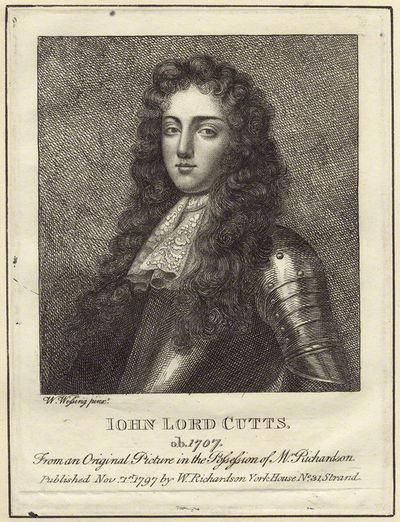Annotation:Lord Cutt's March: Difference between revisions
No edit summary |
No edit summary |
||
| (6 intermediate revisions by 2 users not shown) | |||
| Line 1: | Line 1: | ||
---------- | |||
---- | {{TuneAnnotation | ||
|f_tune_annotation_title= https://tunearch.org/wiki/Annotation:Lord_Cutt's_March > | |||
'''LORD CUTT'S MARCH'''. English, Country Dance Tune or March (cut time). G Major. Standard tuning (fiddle). AABB. The tune was published in all four editions of John Young's '''Second Volume of the Dancing Master''' [http://www.izaak.unh.edu/nhltmd/indexes/dancingmaster/Dance/Play5566.htm] (1710-1728), and in rival publishers Walsh and Hare's ''' Second Book of the Compleat Country Dancing-Master''' (1719). | |f_annotation=[[File:cutts.jpg|400px|thumb|right|Lord John Cutts]]'''LORD CUTT'S MARCH'''. English, Country Dance Tune or March (cut time). G Major. Standard tuning (fiddle). AABB. The tune was published in all four editions of John Young's '''Second Volume of the Dancing Master''' [http://www.izaak.unh.edu/nhltmd/indexes/dancingmaster/Dance/Play5566.htm] (1710-1728), and in rival London publishers Walsh and Hare's ''' Second Book of the Compleat Country Dancing-Master''' (1719). | ||
<br> | <br> | ||
<br> | <br> | ||
Lord Cutt was a military figure. See also "[[My Lord Cutt's Delight]] | Lt. General Lord (John) Cutt [http://en.wikipedia.org/wiki/John_Cutts,_1st_Baron_Cutts] (1661-1707) was a military and literary figure who commanded a regiment for King William in Holland, and later in his Irish wars of 1690, and a division under Churchill at the Battle of Blenheim. General Hugh Mackay described Cutts in 1687 as "pretty tall, lusty and well shaped, an agreeable companion with abundance of wit, affable and familiar, but too much seized with vanity and self-conceit." He was popular and cut a dashing figure, and was a favorite in court, though sometimes lampooned for his fondness of poetry and the arts. Cutt was Colonel in charge of the Coldstream Guards in 1698 when fire broke out in Whitehall Palace (then the Royal Residence), and he led the force in trying to extinguish the conflagration; to no avail, as the building was nearly completely consumed. See also "[[My Lord Cutt's Delight]]" from Henry Atkinson's 1694/95 music manuscript [http://www.asaplive.com/archive/detail.asp?id=R0203601], presumably composed on the same person. Atkinson's tune was published by Henry Playford under the title [[St. Catherine]]." | ||
|f_source_for_notated_version= | |||
|f_printed_sources= | |||
|f_recorded_sources= | |||
|f_see_also_listing= | |||
}} | |||
Latest revision as of 03:03, 3 February 2024
X:1 T:Lord Cutt’s March M:C| L:1/8 R:Country Dance B:Playford DM 1710 K: G G2 GG G2A2|B2 BB B2G2|d2e2d2 cB|A4 A4:|| d2 dd d2d2|e2 ee e2e2|a2e2e2g2|f3e d2d2| gdde eAAd|dGGd c2B2|c2e2d2 cB|A4 G4:|]

Lt. General Lord (John) Cutt [2] (1661-1707) was a military and literary figure who commanded a regiment for King William in Holland, and later in his Irish wars of 1690, and a division under Churchill at the Battle of Blenheim. General Hugh Mackay described Cutts in 1687 as "pretty tall, lusty and well shaped, an agreeable companion with abundance of wit, affable and familiar, but too much seized with vanity and self-conceit." He was popular and cut a dashing figure, and was a favorite in court, though sometimes lampooned for his fondness of poetry and the arts. Cutt was Colonel in charge of the Coldstream Guards in 1698 when fire broke out in Whitehall Palace (then the Royal Residence), and he led the force in trying to extinguish the conflagration; to no avail, as the building was nearly completely consumed. See also "My Lord Cutt's Delight" from Henry Atkinson's 1694/95 music manuscript [3], presumably composed on the same person. Atkinson's tune was published by Henry Playford under the title St. Catherine."

